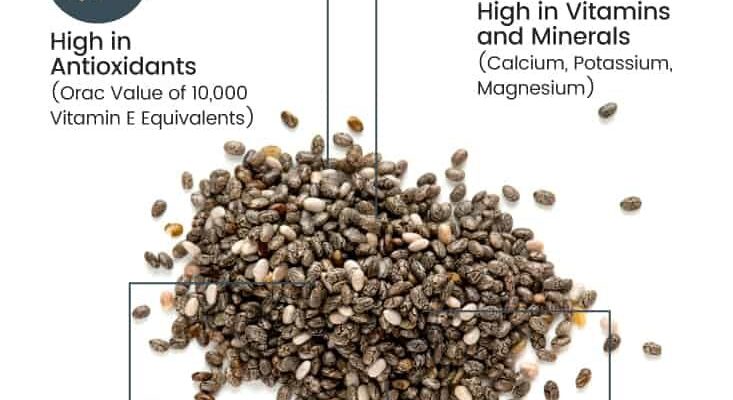Ancient grains and seeds are all the rage in today’s health-conscious world, and one superfood that has stood the test of time is chia seeds. These little nutrient powerhouses have been around for centuries, and they’ve recently made a big comeback. But how do you eat chia seeds, and what can you do with them? This article will guide you through various ways to consume these versatile and healthy seeds, as well as some delicious recipes to try.
The Basics: How to Prepare Chia Seeds for Consumption
Chia seeds come from the Salvia hispanica plant, native to Central America. They are small, oval-shaped, and come in a variety of colors such as black, white, and brown. Before diving into the different ways you can eat chia seeds, let’s discuss how to prepare them properly.
Raw Chia Seeds
You can eat chia seeds raw, straight out of the bag. Raw chia seeds have a mild, nutty flavor, making them an excellent addition to various dishes. However, it’s essential to chew them thoroughly before swallowing since they can expand in your stomach and cause discomfort if swallowed whole.
Soaking Chia Seeds
To unlock the full nutritional benefits of chia seeds and make them easier to digest, soak them in liquid for about 15-20 minutes. The seeds will absorb the water, forming a gel-like consistency. Use a ratio of 1 tablespoon of chia seeds to 3 tablespoons of water. Once soaked, you can store them in the refrigerator for up to one week.
Ways to Incorporate Chia Seeds Into Your Daily Diet
Now that you know the basics of how to prepare chia seeds, it’s time to get creative with incorporating them into your meals. Here are some ideas on how to eat chia seeds:
Smoothies and Beverages
One popular way to enjoy chia seeds is by adding them to smoothies. Chia seeds blend well with fruits, vegetables, and various liquids, such as milk, yogurt, or fruit juice. Simply add a tablespoon of soaked chia seeds to your favorite smoothie recipe for an extra boost of nutrients.
Besides smoothies, you can also add chia seeds to other beverages like tea, coffee, or even water with a squeeze of lemon. This not only adds texture but boosts the nutritional content of your drink.
Yogurt and Parfaits
Mixing chia seeds with yogurt is another easy way to incorporate them into your diet. Simply stir in a spoonful of soaked chia seeds into your favorite yogurt and enjoy. You can also create delicious parfaits by layering yogurt, fruits, and chia seeds, then topping them off with granola or nuts.
Puddings and Desserts
Chia seed pudding is a popular and healthy dessert option. To make chia seed pudding, combine 1/4 cup of chia seeds with 1 cup of liquid (milk, almond milk, or coconut milk) and a sweetener of your choice, such as honey or maple syrup. Let the mixture sit in the refrigerator for a few hours or overnight to thicken. Top with your favorite fruits, nuts, or spices to customize your pudding.
In addition to pudding, chia seeds can be used as a thickener in other desserts like pies and fruit compotes.
Chia Seeds in Baking
Besides adding chia seeds to various dishes, you can also use them as an ingredient in your baking recipes. Here’s how:
Chia Seed Egg Substitute
If you’re looking for a vegan or egg-free alternative in baking, chia seeds can replace eggs in many recipes. To make a chia seed “egg,” mix 1 tablespoon of ground chia seeds with 3 tablespoons of water and let it sit for a few minutes until it forms a gel-like consistency. This mixture is equivalent to one egg and works well in muffins, pancakes, or cookies.
Adding Chia Seeds to Baked Goods
You can easily incorporate chia seeds into your favorite baked goods by adding a couple of tablespoons to the batter or dough. Chia seeds work well in recipes like bread, muffins, cookies, and pancakes. They not only add nutrition but also provide a slight crunch and texture to the finished product.
Incorporating Chia Seeds Into Your Meals: Breakfast, Lunch, and Dinner
Now that we’ve covered some basic ways to eat chia seeds, here are some ideas on how to include them in your daily meals:
- Breakfast: Sprinkle chia seeds over your oatmeal, cereal, or toast with peanut butter and honey. You can also add them to your morning smoothie or juice.
- Lunch: Mix chia seeds into your salads, sandwiches, or wraps. For example, try adding them to tuna salad, chicken salad, or hummus for extra nutrients and texture.
- Dinner: Incorporate chia seeds into your main dishes by using them as a binder in meatloaf, burgers, or meatballs. You can also mix them into rice, quinoa, or couscous for added texture and nutrition.
These are just a few ways to incorporate chia seeds into your daily meals and reap their numerous health benefits. With their impressive nutritional profile and versatility, it’s no wonder these tiny seeds have become a staple in many kitchens around the world.



Comments